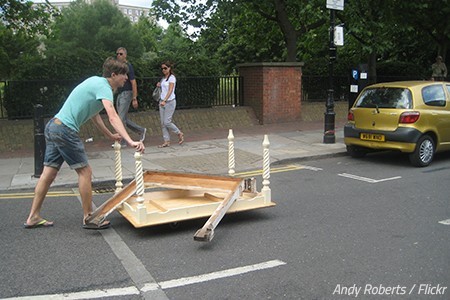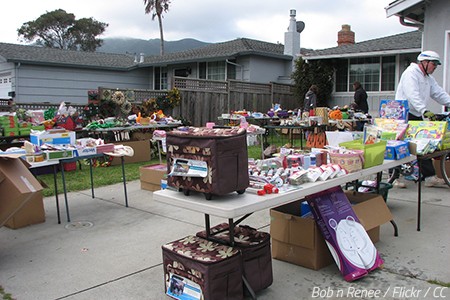You’ve probably heard numerous clever quotes about making mistakes in life, and until you’re the one blundering, those words of wisdom actually sound fine.
Depending on your current state of mind, such quotes can even be somewhat inspirational: Mistakes are stepping stones to success. But make no mistake, once you find yourself on the other side, the grass doesn’t even seem remotely green. Make a costly blunder and you may not be able to see any grass at all.
Now, it’s never fun to err, especially during a period where there’s a bad combination of elevated stress, money at stake, and too little time – like a house move, for example.
Without a doubt, moving from one home to another is a unique period in one’s life where the extremely transitional nature of the life-changing event tends to put a lot of pressure on people. And as you can imagine, increased levels of stress lead to a higher number of errors from the people who are often already too stressed out as it is.
If you yourself are facing a house move anytime soon and you’re thinking of moving on your own, then it’s extremely important that you stay away from serious trouble by avoiding the most common mistakes when moving on your own.
Some move-related mistakes are too insignificant and you can simply ignore them – for example, forgetting to clean your refrigerator prior to moving day. Other errors will greatly slow down your progress – running out of essential packing materials, for instance. And yet, there are blunders that could really cost you – hiring the services of a bad moving company is definitely one of them.
Stay safe. Stay protected. Avoid these Do-It-Yourself mistakes when moving by yourself.
Mistake: Professional movers are too expensive!
It’s a common misconception to assume that professional relocation services are always much costlier than organizing and executing a Do-It-Yourself house move.
The truth is that it’s very hard, and even unfair, to make general comparisons due to the fact that the moving price is formed on a case-by-case basis. In other words, because of the great number of additional factors that affect the final moving price, no two house moves will cost the same even if they seem very similar.
With experienced movers, you can rest assured that your prized possessions are in good hands.
Generally speaking, moving by yourself will be cheaper only when
you’re moving within the same town and city,
you’re moving locally within a radius of 100 miles and will not be crossing any state lines,
you have previous experience in organizing a house move,
you’re moving out of a relatively small home with not too many, too heavy, or too expensive household items in it, and
you know you can rely on a few good friends to give you a hand when you need it the most.
10 Tips for Hiring Great Movers
Don’t make the moving mistake of assuming that hiring a professional moving company will cost you more, especially if you don’t meet all or almost all of the conditions above.
Once you leave the realm of a local move, a top-rated cross-country mover becomes vital for the successful end of your relocation adventure. After all, not for a moment should you forget the staggering number of hidden costs when moving on your own:
obtaining quality packing materials,
renting a moving vehicle and moving equipment,
purchasing adequate relocation insurance,
paying for road tolls and taxes,
paying for additional loading/unloading labor,
food and lodging along the road, etc.
How Much Does It Cost to Hire Movers?
Mistake: I can pack up my stuff in a couple of days
Let’s get straight to the point: packing up a house for a move is NOT just another task you need to mark as checked before Moving day comes around. No matter how you look at it, packing is the most important job during your pre-move preparations and failure to approach it with the urgency and dedication it requires could easily become one of the most serious mistakes when moving yourself.
Regrettably, packing for a move is also the most time-consuming task of them all. And so, thinking that you can pack up all your things in just a few days proves to be a serious mistake that often leads to failure to finish the packing task on time.
Don’t make the mistake of underestimating the time you’ll need to sort out, wrap up, and box all the miscellaneous items found in your home. One rule of thumb is to double the time you think you will require to complete the packing project.
Here are a few tips to help you speed up packing:
Start thinking about packing up your home as soon as you know for sure that you’re moving to a new home. Or on the next day at the latest. It’s easy to underestimate the staggering amount of time that packing up for a move requires, and it’s even easier to switch into a procrastination mode. Trust us – just don’t it.
Create a packing calendar to introduce discipline and order into your packing process. Start the process from the premises that are the hardest ones to sort and pack – storage rooms (garage, basement, attic, spare rooms), and the kitchen.
Packing up an entire home is a challenge that cannot usually be managed by only one person. To avoid falling behind your packing schedule, ask your good friends to lend you a hand, or even better – if you can afford it, hire professional packers to finish the job several times faster and several times safer.
Packing Checklist: Packing Timeline for Moving
Mistake: I can use any boxes I can get my hands on
Whatever you do, you can’t really hide from packing.
When you don’t have enough house moving experience, mistakes can appear out of nowhere when you least expect them. One moment you’re seemingly doing fine and the next moment – you’re in trouble without having a clue how you got yourself into that messy situation.
Most people tend to learn from their mistakes but when you yourself are moving out for the first time, it can be very difficult to avoid some tricky mistakes simply because you don’t have the experience to sense that something’s wrong before it happens.
To reduce packing costs, you may seriously consider using second-hand cardboard boxes that you get for free. And why wouldn’t you? Taking into account that one brand-new cardboard box costs roughly $2 and the average number of boxes to pack up an entire household is approximately 60, then you can definitely see that paying well over $100 for packing boxes alone is not something to look forward to.
Getting free moving boxes can work great in your case but you shouldn’t make the DIY mistake of accepting just any box that comes your way for free. Make sure the free cardboard boxes you do use to pack up your things are:
CLEAN. Inspect each box closely and do not accept a container that’s not clean enough for your packing needs.
DRY. Wet areas on a box will certainly compromise its sturdiness and integrity, which in turn will increase the chances of Moving day accidents. Accept only cardboard boxes that are perfectly dry.
DURABLE. Each container should be visibly strong and with available flaps before you agree to use it to protect your items on the road.
Where to Find Free Moving Boxes
Mistake: I can pack my things better than professionals
It’s OK to have the confidence that you can pack up your things well enough to survive the move, but to think you can do it better than experienced professional packers can be a bit over the top.
In order to lower moving costs, you’re likely to decide to pack up your things by yourself instead of paying professionals to do it for you. And that can be the right decision as long as you remember to follow some fundamental packing rules:
Inventory and sort out your items before packing them up – this is a crucial step you should NOT skip. That’s right – don’t even think about packing all of your earthy possessions without sorting them out first… unless you really wish to lose extra valuable time and waste even more valuable money. Make a detailed home inventory to help you slim down the number of your belongings prior to the move.
Get hold of quality packing supplies to ensure that nothing bad happens to your prized possessions. Safety is a real concern when moving home yourself – especially when you’re packing on your own. Securing all packing supplies in advance will also help you avoid losing time by having to halt your packing momentum to search for additional packing materials.
Use plenty of packing paper and bubble wrap when protecting breakable items that have a very high chance of not surviving the move due to their fragile nature. Any items made of glass, china, or porcelain should be padded up really well to make it safely to the new place.
Keep in mind that just because you own your things doesn’t mean that you can pack them more quickly and safely than professional packers can. If you’ve got too little time for packing up your items, you’re moving too many fragile items or specialty items that require special packing care, then you should still consider hiring professional packers for peace of mind.
Professional Packers Guide: All You Need to Know
Mistake: Renting a moving truck is child’s play
The important job of loading a rented moving truck on your own is not to be underestimated.
As far as DIY moving tips go, an important stage in most self-moving adventures is to secure a vehicle with which to transport your household items. And when it comes to self-move rental trucks, there are some not-so-funny mistakes you should avoid at all costs.
Renting a smaller truck
If you select a rental truck with smaller storage capacity than you need for your stuff, then you might be forced to make more than one trip to your destination (which may not be possible at all).
Or you may need to return the vehicle and rent a larger one, which will mean loads of wasted time and nerves.
Renting a bigger truck
If you choose a truck with larger space than you actually need, not only will you be paying for extra storage which you have no way of utilizing, but you will also run the risk of damaging some of your belongings if you fail to secure them well for safe transportation. Still, it’s the “preferred” mistake out of the two scenarios.
Above all, it’s useful to have a basic understanding of the approximate capacities of self-move rental vehicles. Here are some approximate truck capacity calculations to help you make a good choice.
However, you should still discuss this important issue with a knowledgeable representative of a truck rental moving company before your final decision.
Pickup truck. Good for small loads and partial moves.
Cargo van. Suitable for college moves, partial moves, or moving out of a studio apartment when moving locally.
10-12 foot truck. Ideal for college moves and small apartments.
14-17 foot truck. Good for moving out of a 1-2 bedroom homes or smaller offices. These are the most common rental moving trucks on the market.
20-26 foot truck. Ideal for moving the household items found in large 3, 4 bedroom homes.
10 Tips for Renting a Moving Truck for Your DIY Move
Mistake: Driving a moving truck is just like driving a car
One serious mistake that you may make while organizing a self-move is to assume that rental trucks are nothing but bigger cars. In a way they are, but driving a moving truck across the country is not the same as driving a passenger car.
Even before you reach the moment of driving the truck rental, you will need to make sure the freight vehicle is loaded up correctly in terms of distributing the cargo weight safely and securing your items inside the back of the truck so that they don’t move around during the trip.
Click here to learn the best way to load a moving truck in the safest way possible. In fact, you don’t have to be a tile-matching champion to succeed – a few good loading tips and a few good friends should help you pull it off.
Now, driving a moving truck across the country can be challenging on several levels, and the sooner you realize it, the more time you should spare to prepare for it:
Build to the desired speed gradually since accelerating too quickly will increase the fuel consumption and may cause the cargo in the back to shift.
Apply the brakes early and go easy on them. Don’t brake suddenly and abruptly for fear of throwing the entire moving truck off balance.
Keep a safe distance from other vehicles as trucks cannot stop as quickly as passengers cars can. Make an effort to stay at least 4 seconds behind the vehicle that’s directly in front of you.
Don’t overtake other vehicles unless you really have to do it. Be extra careful when changing lanes.
Be very careful when you park the moving truck – always use the parking brake and turn the wheels away from the curb when facing an uphill, and vice versa.
Keep an eye out for those tricky overhead clearance signs. Never go under an underpass unless you’re sure the rental truck can go through it without any damage.
12 Tips for Driving a Rental Truck Safely and Risk-Free
Mistake: My friends will gladly help me move out
Having your friends bail out on you at the last minute could really complicate things for you.
One thing you should do at all costs when moving on your own is to explore your self-moving options as far as they can go. Of all the self-move mistakes to avoid, the costliest error you can ultimately make is to underestimate the complexity of the upcoming relocation, and therefore only think you’ve got all the bases covered.
As mentioned above, a self-move is not the right time to attempt to prove to yourself that you can manage all the tasks without assistance of any kind. If you can’t afford to let professional packers and movers take care of the toughest relocation stages for you, then you will most definitely need to reach out to your friends and ask them for help.
However, don’t make the self-moving mistake of assuming that your pals are obligated in any way to give you a hand. On the contrary, they will probably be dealing with complicated work schedules, previous commitments, and other responsibilities, so
contact them as early as you possibly can to maximize your chances of positive answers;
make an effort to ask them for help face to face, if possible;
don’t try to underplay the amount of work they are expected to help out with, but be a straight shooter from the start;
show understanding to the ones who cannot lend you a helping hand for one reason or another;
prepare and organize in advance whatever you can yourself to save your friends much valued time and efforts; and
remember to show your enormous gratitude and reward their sacrifice in a way that you seem to be the most appropriate and memorable.
How to Get Friends to Help You Move
Mistake: I’m immune to move-related injuries
It’s important to keep in mind that some DIY moving mistakes can be rather painful – literally!
One of the major differences between having professionals handle a house move and having non-professionals do it is the level of overall safety. In fact, professional movers are specifically taught how to reach and maintain the highest degree of safety when working on a move – both personal safety and protection of property.
Therefore, if you have decided to undertake the DIY approach to moving to another home, don’t make the mistake of assuming that you are immune to any type of accident. Instead, follow this self-moving advice to stay on the safe side of things from Day 1.
Avoid personal injuries by using your common sense at all times. Before having to lift and move heavy furniture pieces with your pals, make sure 1) the walking path is clear of any obstacles, 2) you use proper moving equipment /an appliance dolly, moving straps, etc./, 3) you know the proper lifting techniques to avoid nasty (back) injuries, 4) you wear durable work gloves to protect your hands and fingers, and 5) you have your most comfortable pair of shoes with excellent traction and ankle protection.
Remember to 1) double tape your cardboard boxes even if they seem sturdy enough, 2) place clean sheets of paper on the bottom of each box to protect, 3) use plenty of crumpled packing paper, bubble wrap, or pieces of clothing to create cushioning layers inside the moving boxes and fill up any empty spaces, and 4) keep all your moving containers less than 40 pounds each.
Don’t make the self-move mistake of letting small children and/or pets be around the action on Moving day! Too many pairs of playful feet could endanger the safety of the entire DIY moving operation. Keep your loved ones away from the moving epicenter for both your sakes.
20 Moving Safety Tips: Stay Safe When Moving
The post Moving by Yourself? Don’t Make These Costly Mistakes appeared first on The Moving Blog.







